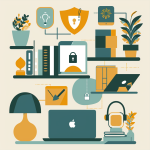In today’s digital age, staying connected and informed often requires a basic understanding of technology. For seniors, learning to use smartphones and computers can open up new avenues for communication, entertainment, and convenience. Here are some easy-to-follow guides to help you get started with using smartphones and computers.
Understanding Smartphones
Smartphones are powerful devices that combine the functions of a phone and a computer. Here are the basics to get you started:
Setting Up Your Smartphone
- Choose the Right Device: Select a smartphone that suits your needs and budget. Popular options include the iPhone, Samsung Galaxy, and Google Pixel.
- Set Up Your Phone: Follow the on-screen instructions to set up your phone. This usually involves selecting a language, connecting to Wi-Fi, and signing in with a Google or Apple account.
- Adjust Settings: Customize your settings to your preferences. This includes adjusting the screen brightness, setting up a passcode, and enabling accessibility features like larger text or voice control.
Making Calls and Sending Messages
- Making a Call: Open the Phone app, enter the phone number using the keypad, and press the call button. To end the call, press the red hang-up button.
- Sending Text Messages: Open the Messages app, select the compose button, enter the recipient’s phone number or select a contact, type your message, and press send.
Using Apps
- Downloading Apps: Open the App Store (iPhone) or Google Play Store (Android), search for the app you want, and press the download button. Popular apps for seniors include Skype, Facebook, and Zoom for staying connected, and health apps like MyFitnessPal.
- Organizing Apps: Press and hold an app icon to move it around or create folders. Group similar apps together, like communication apps, health apps, and entertainment apps.
Navigating Computers
Computers provide a wide range of functions, from browsing the internet to creating documents. Here’s a simple guide to help you get started:
Setting Up Your Computer
- Choose the Right Computer: Decide between a desktop, laptop, or tablet based on your needs. Laptops are portable, while desktops offer larger screens.
- Initial Setup: Follow the on-screen instructions to set up your computer. This typically involves connecting to Wi-Fi, creating a user account, and adjusting settings.
Basic Functions
- Using the Keyboard and Mouse: Learn the basic functions of the keyboard and mouse. Practice typing and using the mouse to click, drag, and drop.
- Creating and Saving Documents: Open a word processing program like Microsoft Word or Google Docs, type your document, and save it by selecting “File” and then “Save As.” Choose a location and name your file.
Browsing the Internet
- Opening a Browser: Click on your preferred web browser, such as Chrome, Firefox, or Edge.
- Navigating Websites: Type the web address in the address bar and press Enter. Use the search bar for topics you want to find. Bookmark frequently visited websites for easy access.
- Online Safety: Be cautious when browsing the internet. Avoid clicking on suspicious links, and ensure websites are secure (look for “https” in the URL).
Tips for Staying Safe Online
- Use Strong Passwords: Create strong, unique passwords for each of your accounts. Use a combination of letters, numbers, and special characters.
- Enable Two-Factor Authentication: This adds an extra layer of security to your accounts by requiring a second form of verification.
- Be Wary of Scams: Be cautious of emails, messages, or websites that ask for personal information or payment. Verify the source before providing any details.
- Keep Software Updated: Regularly update your operating system and apps to protect against security vulnerabilities.
Conclusion
Learning to use smartphones and computers can greatly enhance your ability to stay connected, informed, and entertained. By following these easy-to-understand guides, you can become more comfortable with technology and take advantage of the many benefits it offers. Remember, practice makes perfect, and don’t hesitate to seek help from friends, family, or online resources.



